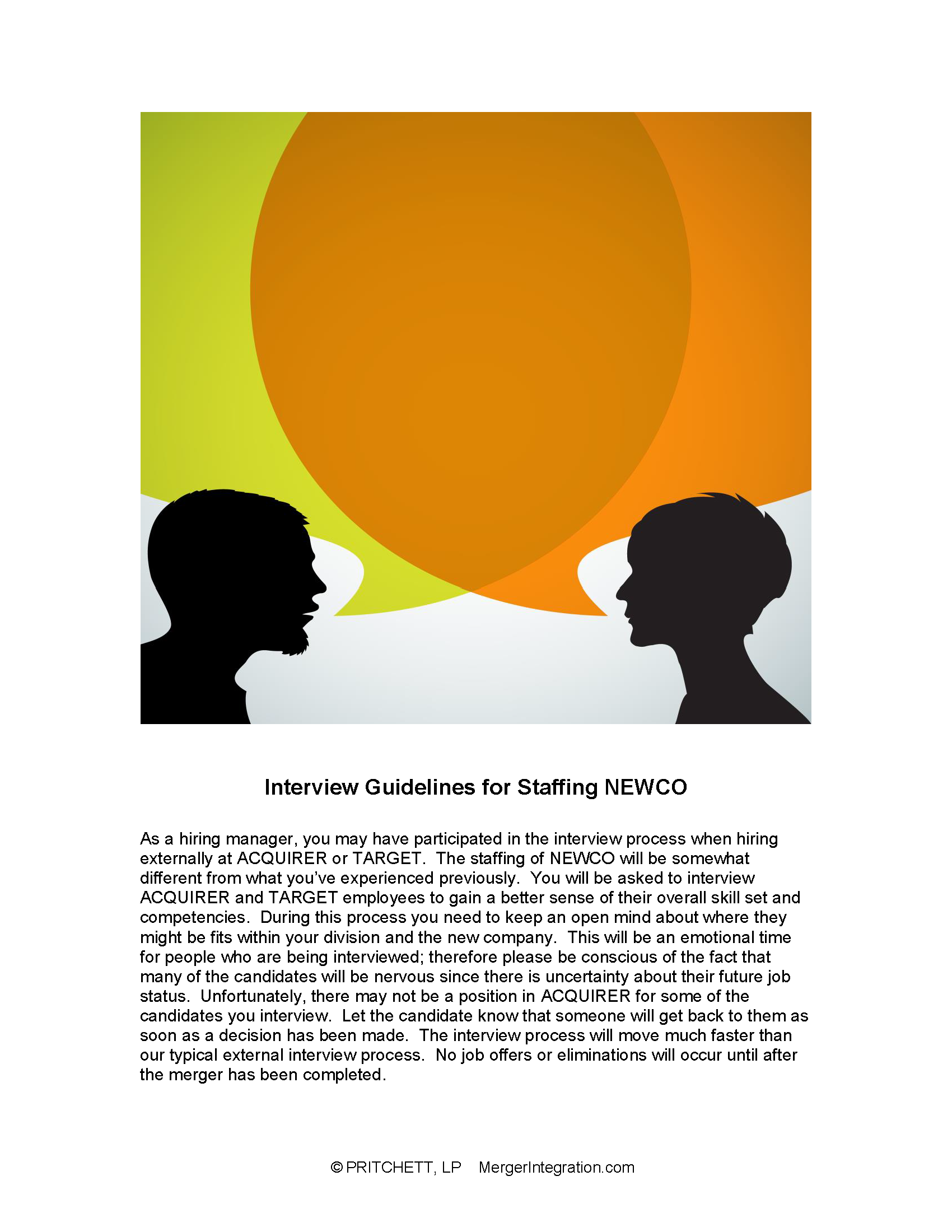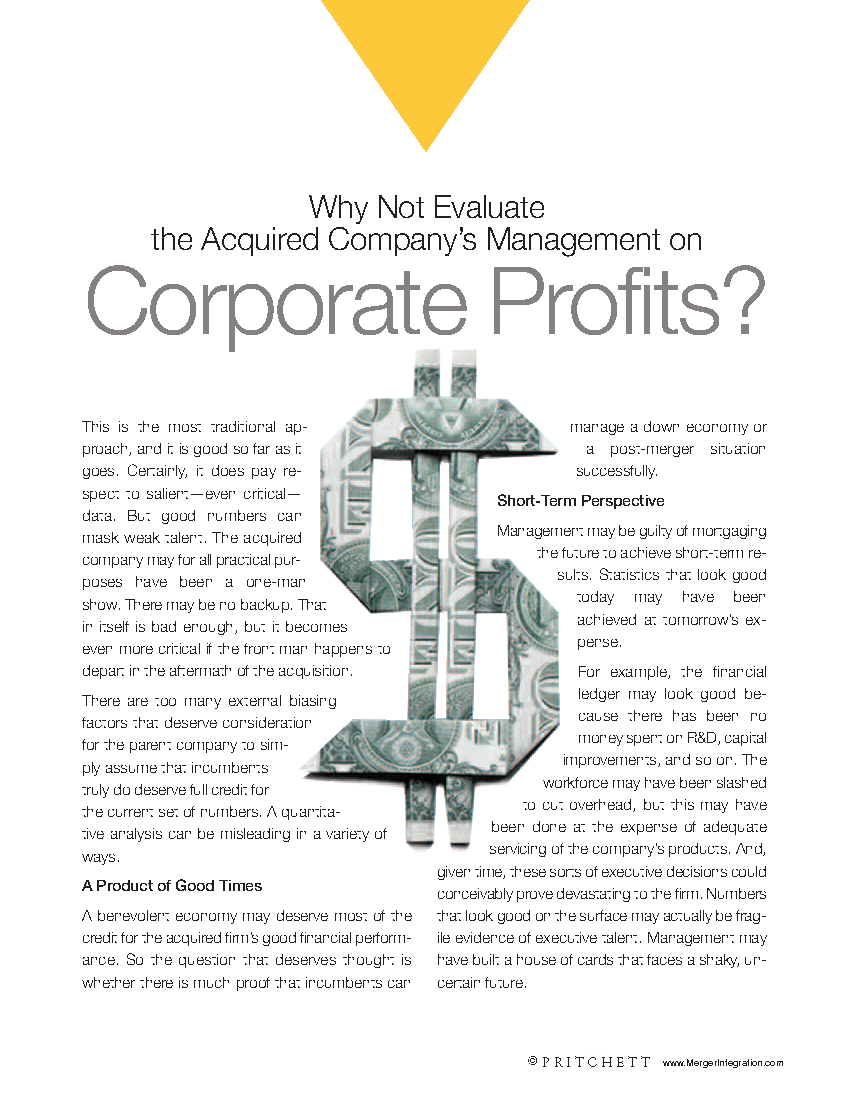INTRODUCTION
Over the years, the conventional process of making staffing changes on the heels of an acquisition has taken one of two forms. Sometimes the acquired firm steps in early to make people changes, whether in just a handful of positions or with wholesale reorganization. In the other approach, the parent company attempts to maintain a hands-off stance again, except for perhaps one or two initial changes until several months have elapsed that hopefully allow enough time for everyone to calm down and become adjusted to the situation. One of the familiar steps in this second tactic involves assurances from executives in the parent company to the effect that, “We don’t plan any personnel changes.”
In both of these approaches, however, the critical element that’s missing is a systematic, incisive assessment of what the acquisition brings vis-à-vis management and technical talent. Typically, the acquiring firm will take a piecemeal approach, wherein a few people here and there are evaluated in a professional fashion. Or a number of people may be appraised in a sketchy manner but so superficially that much room remains for potential problems to develop.
Top management in the acquiring firm might argue that it is best to allow some time for them to get to know the abilities and potentials of the management team in the target organization. But that assumes that those people will hang around long enough for such a familiarization process to occur. Often they do not. Furthermore, while taking the slow route, a part of this getting-acquainted exercise may consist of seeing bad management decisions being made, mistakes that could have been prevented. Likewise, key opportunities may be lost. All in all, this can prove to be an expensive and time-consuming education process. This approach also drags out the integration of the two firms. It forestalls needed resolution and leaves questions unanswered, prolonging the anxiety and ambiguity, thus contributing to the chronic problem of post-merger drift.
This approach is not necessarily a kind and thoughtful way of dealing with staffing matters. Nor is it likely to be viewed favorably by people in the acquired organization. Rather than looking on this as a fair and equitable opportunity to prove themselves, they will more likely be anxiously waiting to see when and where the axe will fall.
The situation feels like benign neglect to people in the acquisition, as if they are being left to dangle helplessly in the wind. In their opinion, it would be better to get closure, to be appraised promptly and fairly, so that they can get on with their careers either secure in the merged firm or somewhere else.
Why Should Incumbents Be Evaluated?
It might be argued that in several merger scenarios it is best to go with the status quo—that is, move on the premise that the incumbent management team is sound and that the acquiring company should not fool around with something that’s working. This line of reasoning sounds good on the surface, especially if the acquired firm is financially healthy and has a pretty good track record. Upon careful scrutiny, however, it proves to be flawed in a number of respects.
Some Incumbents May Not Play to Stay
To begin with, the acquirer needs to ascertain who plans to remain on board. The new owner may be extremely fond of the new charges and fully confident that they can continue to operate the company in a successful fashion. But that’s no guarantee whatsoever that the feelings are reciprocal. Even if these incumbents are not grumbling, even if they appear to be reconciled to the situation, in-depth data gathering often proves otherwise. The acquirer should rapidly identify fast-track, high-talent employees so that the parent company can put forth special efforts to retain them. Often these people can be “hooked” with heavy-duty assignments and special developmental opportunities that clearly communicate the key role they can play in the organization’s future.
It is particularly important for the new owner to take pains to identify these people and tie them to the organization if the acquisition represents a move by the parent company into new terrain, for example, unfamiliar products/services and different markets. The less one understands the business that has been bought, the more crucial it is to keep those people on board who do have a firm grasp of what it takes to make the business a success. The same general idea holds true, of course, if the acquirer does not have any surplus management talent to speak of that could be sent across to manage things in the event key vacancies develop in the acquisition. And after an adversative merger battle has been fought, as in a raid or contested situation, the question of who is willing to stay is a particularly sensitive issue.
Some People Should Be Repositioned or Terminated
Virtually any management team has a weak link here or there. And the odds are that even a successful company can work better if the weaker performers are identified. This does not mean that they will always be replaced. But parent company executives can determine how best to maneuver around a person’s shortcomings through the use of support personnel, changing certain features of the job itself, or focusing on developing the incumbent’s skills. At any rate, the parent company can be well served by management vulnerabilities. It can preempt many nasty, costly surprises by giving the parent firm an opportunity to take preventive measures.
Also, if the merger has brought about departmental overlap or duplicated functions, and the integration game plan calls for keeping only one person in those situations, an early evaluation will indicate which person should be groomed to fill the opening.
Data for Management Succession Planning
The acquirer needs to know where promotion potential exists in order for good management succession planning to take place. There is virtually always some early turnover in key management positions, and decisions must be made regarding promotions, transfers, and recruitment of new blood. A broad-gauged management assessment develops the kind of database necessary to move decisively in those situations.
Executives in the parent company can benefit from having an accurate “fix” on people’s limits plus their potential for shouldering heavier duties or altogether different types of assignments. The merger/acquisition arena is no place for trial-and-error staffing decisions.
Learn How to Manage and Motivate
By getting a quick, comprehensive set of insights into the makeup of the management corps in the acquired company, the parent firm possesses the information needed to best manage and motivate these people from day one.
Ordinarily, it will be found that some of the acquired personnel need generous job structure—that is, clear-cut marching orders, very specific objectives, and definitive procedural guidelines. Others will operate best in an environment where they are given very free rein and generous latitude to exercise their own judgment. Some people are best motivated by attention, approval, and hand-holding. Others will perform best under a strict boss who is quick to discipline.
The key point here is that it is very easy to mismanage, and therein demotivate, people you don’t know. It also is extremely easy to violate the practices people have grown accustomed to over the years. When that happens, the odds are significantly increased that bailouts will occur, that people will be recruited away more easily, or at least that their job performance will deteriorate.
Identify Training Needs
Some people—even some of the best talent—need additional training to measure up to the new demands they will encounter. Keep in mind that it is just as likely as not that these people will prefer to keep quiet about the struggle they are having. They will be unaccustomed to asking for help. This suggests, then, that the acquirer needs to be highly sensitive to where incumbent personnel will in all likelihood need training or coaching.
Opportunity for Coaching and Management Development
Since mergers and acquisitions produce so much dissonance, since they are such a destabilizing force, they typically act as an “unfreezing” event for employees. People are jarred out of their familiar routines. There is a significant increase in introspection, leading managers and others to examine themselves and their modus operandi. This mental state makes them far more receptive to the idea of behavior change or efforts aimed toward self-improvement. Thus, on the heels of an acquisition, the timing is right for management-development activities.
A careful, thorough evaluation in this atmosphere produces data that can be shared with an incumbent in a very meaningful feedback session. With receptivity to personal change being at a peak, constructive coaching is far more likely to produce desired behavior change than it would in ordinary circumstances.
Assessing Adaptability
Some people who did well under the old regime will not be able to adapt to the new setup. For example, the new system may not tolerate or indulge their shortcomings and idiosyncrasies.
The company may be moving out of a fast-growth mode into a stabilization period, and this may call for more of a “maintenance manager.” Or it may be that in the months ahead the company will need high-powered marketing savvy more than the financial expertise an incumbent has. A person who did well in a more structured, pre-merger environment may now be surpassed by someone who fared poorly in that world but has the capacity to shine in the current climate of ambiguity.
A systematic appraisal process may well identify which people are likely to become weak performers, passive resisters, or even clear-cut insurgents. It is ironic that usually some of the best people in the acquired company adapt most slowly to the post-merger requirements. This seems to occur because strong performers typically are very committed to their own style and pursue their own priorities with such conviction.
Measuring Motivation
Executives, previously highly driven performers, may lose much of their motivation if the merger makes them independently wealthy. Their commitment may drop with a resulting sag in their day-to-day performance. Entrepreneurial spirit, initiative, and resourcefulness frequently deteriorate in key players once they are cloaked in financial security. There are also other merger dynamics at work to compound the problem: loss of clear role identity, the fact that ultimate fiscal responsibility rests with someone else, less feeling of ownership, a drop in independent authority, and so on.
The owner/entrepreneur, in particular, is prone to feel rather inhibited if he or she remains to operate in the post-merger setting. People such as this are not accustomed to having to answer to anyone. Now, with skilled and rather sophisticated executives there to second-guess and require adherence to a new management style and unfamiliar performance measures, the owner/entrepreneur often becomes anxious. There is an overwhelming fear of being seen as inept. Those who are not insecure may become demotivated out of aggravation. An in-house merger/acquisition paper at Westinghouse submits that few owner/managers are, in fact, worth to the business what it would take to fully motivate them toward long-term, high-level performance on behalf of “their” business. A higher percentage of Westinghouse acquisitions should be accompanied by the planned replacement of top management of the acquired company either immediately or after a short transition period.
So a thorough assessment is serviceable here in two respects: first, in anticipating which personnel are likely to slacken off and, second, in providing the parent company with insight into the trials facing the owner/entrepreneur. The essential point is that incumbents cannot be adequately evaluated strictly on the basis of history or past performance. Rather, they must be measured against the future in terms of what it brings by way of goals to be accomplished and problems to be overcome.
What Really Accounts for the Company’s Track Record?
The company’s past success may be due primarily to factors other than abilities and efforts of incumbent management. A broad-gauged management assessment can give valuable clues regarding this sort of situation.
The same thing is true, of course, in the other direction. A firm that is courting bankruptcy is not always devoid of competent managers and executives. There may well be bona fide winners in the crowd somewhere. If so, they should prove most valuable in helping the acquirer achieve a turnaround, assuming they can be identified and retained.
What's Wrong with Letting Incumbent Executives in the Target Company Submit an Appraisal of Their Own Management Team?
Take what the president, CEO, or owner has to offer, but don’t take for granted that the acquired firm can give you an accurate, unbiased appraisal of its own incumbent managers. The people mentioned may not be able to and may not want to. Usually, the data they supply can be extremely helpful. But they are far from being a sufficiently thorough, reliable critique.
Usually the top-ranking individual gives an off-the-cuff evaluation of key people in the firm, if there is a critique given at all. On one hand, it’s astounding that acquirers are no more consistent than they are in using this person as a source for these data. But it is also amazing that some acquirers are so ready to take at face value what this person might say about subordinates.
There are myriad reasons for questioning the validity and completeness of this person’s critique of management and other personnel in the acquisition. Imagine a situation in which the person involved in negotiating the sale of a company has been asked by the acquirer to evaluate some of his or her key people.
Parting Gestures
This may be the senior executive’s best (perhaps last) chance to repay old debts to incumbents. Thus, it is almost certain that he or she will feel certain obligations to defend them. If the owner has sold the organization and plans to leave the picture, that person will want to be remembered fondly. The executive may also suffer pangs of guilt as a result of having sold the company, and in attempting to assuage these feelings, may allow a positive bias to creep into the management critique.
The Last to Know
It is not uncommon to find that the owner or CEO is actually somewhat out of touch with the people and their plans. It might be, for example, that a couple of key executives are on the verge of leaving to start a competing firm. The top executive almost always fails to maintain an accurate feel for the pulse of the organization when much of his or her time and energies are directed at finding a buyer, negotiating a sale, or perhaps trying to fend off a corporate raider.
Promoting the In Crowd
The key executive who plans to remain in an active role with the firm may strive even unconsciously to entrench loyal supporters and thereby retain a power base. It is extremely difficult to be objective, not protective, of one’s own advocates or constituency.
Wrong Perspective
The acquired company’s top executive may not really grasp what the firm will need by way of management talent in the post-merger situation. He or she may not know where the buyer plans to go with the new acquisition. Unless this executive is really on the right wavelength, the appraisal of subordinates vis-à-vis the new corporate future will be unreliable.
Blind Spots
The owner or key executive in the acquired firm simply may not be a very good judge of talent and ability. He or she may attribute success to the wrong people, such as lauding the vice president of sales for the firm’s revenues instead of crediting some outstanding sales managers who actually managed to achieve the excellent sales volumes in spite of the vice president of sales. It is common to find top executives overrating certain traits or factors while underrating the importance of others. For example, a man who doesn’t like subordinates that challenge him will often view aggressiveness as a negative attribute, when it might be a highly sought characteristic by management in the parent organization.
Pride of Ownership
There is a vested interest on the part of the senior executive who proceeds to critique the strengths and weaknesses of subordinates. After all, this is the person responsible for putting the team together in the first place. In evaluating the management team negatively, the executive would essentially be criticizing his or her own performance. It is very difficult to do that without pulling punches.
Blackball
It may be that a person in the acquired company with real talent has been blacklisted along the way somehow, and thus may not be evaluated justly by superiors.
No Bearer of Bad News
The acquired company’s top officer may say what sounds good instead of laying cold, hard, and unwelcome facts on the line.
Remember, this is the company that the owner or CEO has been trying to sell, and undoubtedly has been presenting in the most favorable light. This person has probably been singing its praises highlighting its good points—while downplaying, ignoring, or even concealing its flaws and vulnerabilities. It could take months to find out just how weak some acquired managers are, and by then the damage is usually already done: Opportunities have been lost, accounts have been bungled, and so on.
Familiar Words, Different Meanings
The key executive in the acquisition probably does not know the parent company well enough to evaluate people from that frame of reference. Parent company norms may be quite different regarding what is seen as good, what is mediocre, and what is weak.
The standards and the semantics can vary dramatically from one company to another, particularly if they are in different industries and are of widely divergent sizes.
Charges of Bias from People in the Acquiring Firm
People in the parent company may not accept the critique as a fair, objective appraisal. Moreover, they probably shouldn’t for the very reasons mentioned above. The more there is to be a true merger of the two organizations, the more this becomes a problem of real significance. If managers or technical personnel from the two companies will be vying for the same slots, a more objective, nonpartisan means of appraising candidates needs to be arranged.
Who's Outside the Inner Circle?
People at the acquired company may wish for an external, objective evaluation that precludes cronyism, nepotism, or other means of playing favorites. Even if the parent company did happen to be comfortable with the idea that the acquisition’s owner or CEO can provide an adequate and equitable appraisal of incumbent managers, some of the people working there may not be comfortable with the idea at all. Furthermore, they may have very good reasons for feeling that way.
Will History Repeat Itself?
Finally, it could well be that some incumbents in the acquired firm will do things (or have done things) for the “old man” they would never do for the parent company—for example, make personal sacrifices or exhibit unusual commitment. The very same people, under the new parent company’s influence and management, may give an altogether different performance. It may be worse; it may be better. Either way, the “old man’s” appraisal of these people may be a very accurate description of what he has experienced in the relationship, but it may not be duplicated under the new regime.
What's Wrong with Having Some Executives in the Acquiring Company Make a Casual, Subtle, Informal Assessment of the Target Company's Management Team?
Again, nothing is wrong so long as this approach is not overrated. This can provide a particularly important assessment on some technical matters and “personal chemistry” issues.
Still, there are a variety of problems in relying on this means of determining the strengths and weaknesses of the acquired firm’s human resources.
Questionable Objectivity
Some of the executives in the parent company may have something to lose. They may have an axe to grind so that they cannot be sufficiently objective. Often, this is an unconscious bias, but very pernicious just the same.
It is conceivable that a particularly high-powered, ambitious individual in the target company poses a bit of a threat to one of the acquirer’s executives, who envisions the possibility that they could both be vying for the same position some day in the not-too-distant future. Or perhaps the parent company executive has been mentoring someone in his own organization who must now compete with this talented newcomer.
Sometimes the bias grows out of the unstated assumption that “We’re the buyer; that must mean we’re better.” This mental syndrome frequently pervades the parent company, adds to the polarization of the two firms, and contributes to unfair comparisons of people.
Evaluate the Evaluator
So much of the time, this sort of appraisal exercise does not play to the strengths of the parent company executives who are involved in the process. They may give it their best shot, and even do a respectable job, but the odds are it does not represent their real forte. This evaluation remains a crucial task, however, and should be conducted in as professional a manner as possible.
Shooting from the Hip
A casual, informal evaluation is just not sufficient. Too much is at stake to take a haphazard, unsystematic approach to appraising the competencies of key people in the acquired firm. But the evaluation is almost always an unstructured exercise when it is being done by parent company executives. Ordinarily, these executives sort of play it by ear, leaning much too heavily on “gut feel,” inconsistent measures, and incomplete data.
Other Priorities
Usually, parent company executives have their hands full doing other things. For them to become heavily involved in this appraisal process pulls them away from tasks where their best abilities likely can be better employed. And the very fact that they are busy and preoccupied with other priorities increases the odds that this task will be shortchanged in terms of the time and effort it receives.
Lowering the Trust Level
If it is very apparent that, in fact, they are being evaluated by the parent company, the incumbents in the acquisition will probably be more guarded and defensive than they would be if they were being evaluated by an outsider. The people under consideration are far more likely to open up and share feelings and perceptions if the evaluation is conducted by someone who can bring objectivity as well as professionalism to the task. Furthermore, incumbents are almost certain to view this evaluation as a more fair and equitable assessment of their abilities and potential.
Wrap-Up Points
To sum up, there are several admonitions the parent company should consider.
First, the new owner should not be tempted to “go with the familiar person.” This tactic does not sufficiently minimize the risks involved.
Second, there is real danger in deciding to “Do nothing and wait for the dust to settle.” It may, on the surface, appear that in employing this approach one is exercising sage restraint. But some good people may choose to leave while the merger is still stirring up dust. Others will have been waffling along with a wait-and-see attitude. And some will have done damage that could have been prevented by a more timely termination or reassignment. Undoubtedly, the organization will have lost some momentum unnecessarily while also wasting an excellent opportunity to motivate people.
Third, sweeping personnel changes that follow closely on the heels of an acquisition, and which proceed without any systematic appraisal of those people being terminated, come at too dear a cost.





